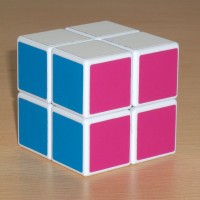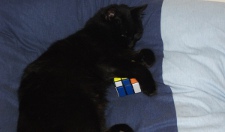Twisting Puzzles
Pocket Cube (2x2x2)

Pocket Cube was the official name for the Rubik's version of the 2x2x2 cube puzzle. It looks a whole lot easier to solve than the standard 3x3x3 cube and it is. It is complex enough however that the solution doesn't fall into your lap the way it does with something like a pyraminx or whip-it.
The Rubik's version of this puzzle tends to be very awkward to turn and not great for speed solving. Eastsheen cubes are better although the mechanism for 2x2x2 cubes is never going to prevent a little bit of sticking here or there. I just use lots of puzzle lube and live with the issues.
The pocket cube is equivalent to a Rubik's cube with no centres or edges. The algorithms that solve these particular parts of a 3x3x3 cube work fine on the little fella. Some people find it a little hard to adjust to treating it as a normal cube and just ignoring the pieces that aren't there. If you can solve a cube, you can certainly solve a pocket cube - you just need to believe.
There are some well-considered approaches to solving the pocket cube and lots of algorithms published. The Ortega method is probably the simplest way to get a speed increase. It has fewer algorithms to learn than the other famous methods. You will also find that you can use these algorithms on lots of other puzzles too. The Guimond method is a beautifully elegant way to reduce time spent on the orientation phase of the solution and uses the same set of permutation algorithms as the Ortega method. A CLL method, combined with the quickest parts of the other two methods tends to lead to the fastest times but has a fair few algorithms to learn. Good if you favour a corners-first approach to solving the 3x3x3 cube - but there are a fair few algorithms to learn.
You can download a program for solving the pocket cube from this page. A tutorial for writing your own solving program in Visual Basic can be found here.

